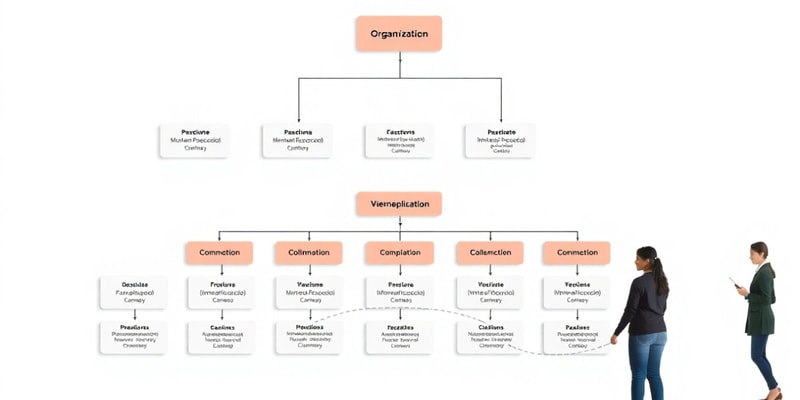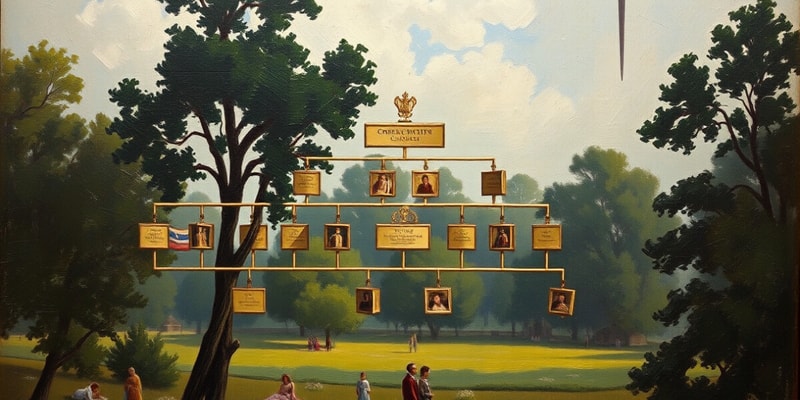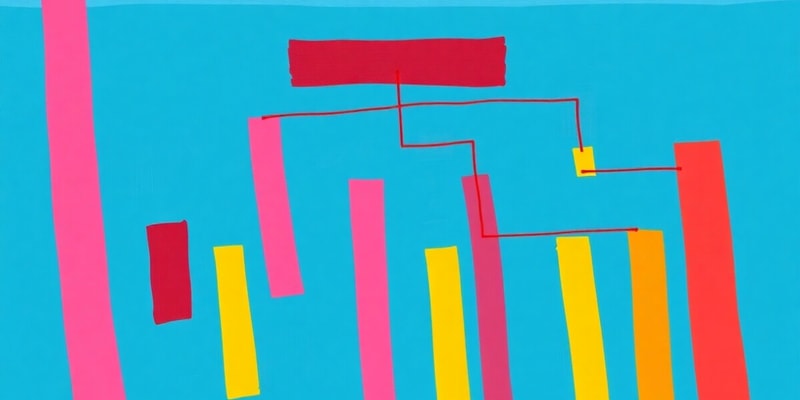Podcast
Questions and Answers
What role does a full-time integrator have within an organization?
What role does a full-time integrator have within an organization?
Which of the following best describes cross-functional teams?
Which of the following best describes cross-functional teams?
What characterizes relational coordination?
What characterizes relational coordination?
In which structure are activities grouped together by common function from bottom to top?
In which structure are activities grouped together by common function from bottom to top?
Signup and view all the answers
What is a key feature of a divisional structure?
What is a key feature of a divisional structure?
Signup and view all the answers
What distinguishes a matrix structure from other organizational structures?
What distinguishes a matrix structure from other organizational structures?
Signup and view all the answers
Which of the following statements about task forces is true?
Which of the following statements about task forces is true?
Signup and view all the answers
What does the matrix structure allow organizations to achieve?
What does the matrix structure allow organizations to achieve?
Signup and view all the answers
What is a primary advantage of cross-functional teams?
What is a primary advantage of cross-functional teams?
Signup and view all the answers
Which organizational structure is effective for high spatial complexity?
Which organizational structure is effective for high spatial complexity?
Signup and view all the answers
What is the primary purpose of vertical linkages within an organization?
What is the primary purpose of vertical linkages within an organization?
Signup and view all the answers
How do rules function within an organization?
How do rules function within an organization?
Signup and view all the answers
Which of the following best describes cross-functional information systems?
Which of the following best describes cross-functional information systems?
Signup and view all the answers
What role do liaison roles play in an organization?
What role do liaison roles play in an organization?
Signup and view all the answers
Which of the following is NOT a characteristic of vertical information systems?
Which of the following is NOT a characteristic of vertical information systems?
Signup and view all the answers
What is a primary benefit of horizontal linkages within organizations?
What is a primary benefit of horizontal linkages within organizations?
Signup and view all the answers
In what situation would hierarchical referral be used?
In what situation would hierarchical referral be used?
Signup and view all the answers
Which aspect is essential for a smooth operation across various departments?
Which aspect is essential for a smooth operation across various departments?
Signup and view all the answers
Which communication method is specifically utilized for passing decisions and information through the hierarchy?
Which communication method is specifically utilized for passing decisions and information through the hierarchy?
Signup and view all the answers
How do plans aid in organizational functioning?
How do plans aid in organizational functioning?
Signup and view all the answers
What is a key feature of the Matrix Structure?
What is a key feature of the Matrix Structure?
Signup and view all the answers
In a Virtual Network Structure, which function is typically kept in-house?
In a Virtual Network Structure, which function is typically kept in-house?
Signup and view all the answers
Which structure is characterized by self-organizing teams managing tasks without traditional managers?
Which structure is characterized by self-organizing teams managing tasks without traditional managers?
Signup and view all the answers
What does the Matrix Structure require organizations to balance?
What does the Matrix Structure require organizations to balance?
Signup and view all the answers
What is a primary advantage of the Virtual Network Structure?
What is a primary advantage of the Virtual Network Structure?
Signup and view all the answers
How are roles typically defined within Holacracy?
How are roles typically defined within Holacracy?
Signup and view all the answers
Which of the following describes a condition necessary for the Matrix Structure?
Which of the following describes a condition necessary for the Matrix Structure?
Signup and view all the answers
What describes the teams in a Holacracy Structure?
What describes the teams in a Holacracy Structure?
Signup and view all the answers
In a Matrix Structure, what is the typical limitation regarding resource sharing?
In a Matrix Structure, what is the typical limitation regarding resource sharing?
Signup and view all the answers
What is a fundamental characteristic of a Virtual Network Structure?
What is a fundamental characteristic of a Virtual Network Structure?
Signup and view all the answers
Study Notes
Organization Structure
- Organization structure defines formal roles, reporting lines, hierarchical levels, and departmental groupings within an organization.
- Smooth operations rely on effective communication, coordination, and integration between departments.
Vertical Information Sharing
- Vertical linkages coordinate activities between top and lower organizational levels, primarily for control.
- Hierarchical referral uses the chain of command: problems are escalated to higher levels for solutions, then solutions are passed down.
- Rules and plans provide standardized responses and information for coordination without constant dialogue.
- Vertical information systems improve efficiency through communication methods like periodic reports, written material, and computer-based communication.
Horizontal Information Sharing & Collaboration
- Collaboration involves joint efforts from different departments to achieve common goals exceeding individual capabilities.
- Horizontal linkages involve communication and coordination across departments.
- Cross-functional information systems facilitate communication and progress updates, enabling horizontal collaboration and coordination.
- Liaison roles facilitate communication and collaboration across departments.
Functional Structures
- Activities are grouped by common function from bottom to top.
- Strengths: economies of scale, in-depth knowledge, skill development, and efficient goal accomplishment.
- Weaknesses: slow response to changes, potential hierarchy overload, poor horizontal coordination, and reduced innovation.
Divisional & Geographic Structures
- Divisional structures, also known as M-form, group activities by product, service, or profit center.
- Geographic structures, similar to divisional, are grouped by geographic location rather than product or service.
Matrix Structure
- A multi-focused structure emphasizing both product and function or geography.
- Strengths: blends product and functional expertise, promotes innovation and product efficiency, and offers strong horizontal linkage.
-
Conditions:
- Pressure to shared resources
- Environmental pressure for multiple outputs
- Complex and uncertain environment
Virtual Network Structure
- Central hub organization manages tasks through external partnerships.
- Key functions are in-house, while outsourced functions are managed through partnerships.
- Strengths: flexibility, market responsiveness, and cost efficiency.
Holacracy Structure
- Self-management structure eliminating traditional managers and distributing authority among self-organizing teams.
-
Strengths: fosters autonomy, accountability, and employee empowerment.
- Weaknesses potentially hindering specific area specialization, and slow down initial decision-making processes.
Teams
- Teams adapt to changing needs.
- Teams self-design operating rules.
- Leadership is distributed.
Studying That Suits You
Use AI to generate personalized quizzes and flashcards to suit your learning preferences.
Related Documents
Description
Explore the concepts of organization structure, vertical, and horizontal information sharing in this quiz. Understand how effective communication and coordination are essential for smooth operations across departments. Test your knowledge on hierarchical linkages and collaborative efforts within organizations.




